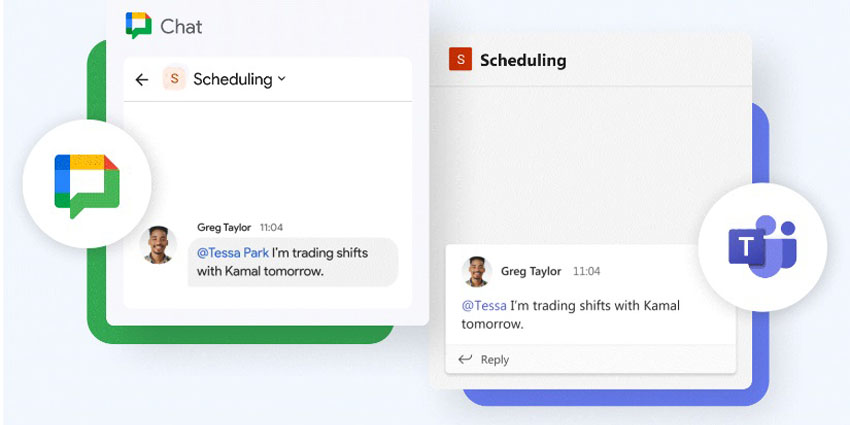What does the future of UC look like? Are mobile, flexible, user friendly platforms built around messaging destined to become the new standard?
Will one-click voice and video conferencing from your GUI ever replace the telephone? And will users slowly abandon email in favour of the real time interactions offered by IM and screen sharing?
This is a vision of workplace communication often painted by team collaboration advocates – a world where the ability to connect through electronic devices means more than just the ability to swap messages or talk. Team collaboration sets its sights on bigger goals, on enabling people to share, plan and work together over distance, in real time.
However, Sahil Rekhi, EMEA managing director at RingCentral, sounds a note of caution. For all its promise, he believes talk of team collaboration making older media like email and telephone obsolete is premature. He believes instead that we are still in the phase of end users finding their feet with team collaboration platforms, working out what they are best suited for and how they can be deployed for maximum results.
In tandem with Email
“The rise in team apps and collaborative technologies has certainly generated interesting headlines and hype about the death of email,” he said. “It’s hard to envisage an overnight withdrawal of a thirtysomething technology, which has become the bedrock of communication within the workplace.
“Therefore – at least for the foreseeable future – email and team apps must find a way to live in concert with one another, especially as team apps depend on email for activation, password reset, and offline push notifications, to name but a few.
“Employees will need to find their mojo when leveraging these tools in their day-to-day environment. For example, we find that many businesses have chosen to maintain email for formal communication with customers and executive management, which is delivered in a polished and professional manner.”
“Team apps, on the other hand, carry a lot of informality and are best leveraged for internal communications between workers. You might, for example, use a team collaboration app to work on a proposal which requires input from different internal departments and teams to complete, but then use email to send the final document. Keep it simple – at least for the short-term. Email for formal, written communication. Team apps for collaboration. One and the other. Not one or the other.”
Sahil also believes businesses need to be wary of believing any old collaboration solution will immediately transform their communications for the better.
He said: “Unfortunately, the premise of ‘build it and they will come’ does not really work with team collaboration, especially as apps are popping up on what feels like a daily basis in the market. It is crucial that the tool being deployed has been carefully selected to address a company-wide challenge or goal that everyone can understand and get behind.
“In fact, we recommend, if time permits, clients pilot any solution with a core group of folks in order to get it right before the first time. This will not only provide you with an opportunity to fine-tune the roll-out but you’ll also be equipped with key-learnings, metrics, answers to FAQs, and fresh ideas to accompany the launch.”
The Three C’s
Sahil suggests that choosing the right team collaboration platform depends on paying attention to the three C’s – communication, collaboration and coordination. He says RingCentral built its own team collaboration platform, Glip, trying to provide a workable solution in all three areas.
“When you’ve made the decision to embrace a team app, it is typically because something, somewhere, in the business requires attention,” he said. “And that’s where one should start – identify that one piece of low-hanging fruit and focus your team app efforts in stabilising the situation. Once you identify that special use case, then set out on a mission to find a solution which will deliver you the full Three C’s:
“Communication: ensure the solution you identify provides you with an array of ‘pret-a-porter’ features, as without communication there is no collaboration. Ensure your solution offers one-to-one and one-to-many messaging, call and event scheduling, video and phone chat, and ultimately, webinar support. Do not settle for one platform, which then encourages you to ‘bolt on’ these other essentials.
“Collaboration: The next step is to confirm that your chosen solution will support the creation of teams, thus enabling you to organise your collaboration activities around a project or a business process. Private messaging which can easily convert to a team conversation should be fundamental to your selection criteria. For example, if Greg and Allison have been collaborating in a private brainstorm, they should be able to convert the session into a more formal initiative, with one-click, and pull in additional participants.
“Image annotations is another great feature to enhance collaboration, e.g. a feature that allows you to drop a pin on an image so that you can have threaded conversations around that pin. With a simple click, employees should have immediate access to colleagues and information, especially information living in other cloud-based solutions, such as Google Docs, the ability to share messages, files, links and other assets, instantly, from any device, at any time.”
“Coordination: Your solution should come equipped with built-in productivity tools, such as task management, file sharing and event scheduling, to help you coordinate your teams around a project. If all the tools you need are in one place and tied together with the communication and collaboration layers, you’ll find that you can spend your time getting work done instead of managing the tools you use to manage your projects.”
Driving transformation
Sahil is convinced that, with the right apps that can deliver on all the 3Cs in a single platform, team collaboration tools can drive wider digital transformation within a business.
“When executed properly, businesses will see cultural and technological barriers start to break down, which in turn will transform the employee’s experience,” he said. “Taking a cloud-first approach will allow businesses to better engage internally and externally, seamlessly share and collaborate, provide quicker access to data to make informed and timely decisions, and when underpinned by an integrated platform, will improve business processes.”
“As part of an overarching strategy which spans people, process and technology, team apps are one of many new technologies and capabilities that businesses will be deploying to improve upon their existing operations.”







